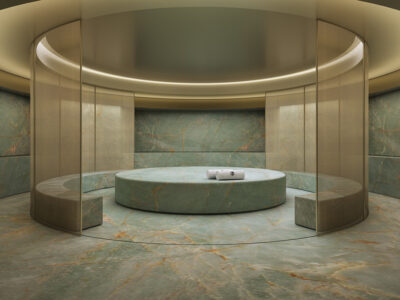|~|Mosaics-body-1.gif|~||~|With its origins in the Orient, and popularised by Chaldean and Roman architecture, mosaics have been a fixture in the decorative art arena for over 4000 years. The Egyptians were the first to discover the fusion of glass and in modern day designs glass mosaics are increasingly used to decorate virtually any surface from swimming pools to flooring, walls, pillars and stand alone decorative accessories.
Most designers have worked with vitreous glass mosaic tiles but for a more sophisticated look, swirled glass mosaic tiles or metallic glass mosaic tiles are ideal. The metallics can even have glittering copper dust marbled throughout, and the effect is stunning. Equally impressive are iridescent glass mosaic tiles. Stainless steel, copper or chrome and even semi-precious stones add distinctive detail and sparkle.
We canvassed a collection of mosaic manufacturers to find out what’s hot this season and what’s on the drawing boards for next year. Elisabetta Zerbato from Bisazza says that: “The best designs/patterns for interior decorations this season are the ones that contain white mosaic and white gold. It can be either stripes or damask as long as it contains white.” Bisazza includes in its ranges a completely clear mosaic in different colours, an iridescent variety and the handcut 24 carat yellow and white gold mosaic. Bisazza is launching its much-awaited new range in September 2006 at the Cersaie trade show in Bologna.
||**|||~|Mosaics-body3.gif|~||~|
As far as mosaic heavyweight, Sicis, is concerned, surfaces exist to be ‘fitted out,’ to be transformed into icons that represent the signs and languages of our time. “It’s the mosaic tesserae, more than any other means, that acts as interpreter, joining together in infinite chromatic and decorative combinations … shaping the outlines of architectural features and living spaces,” says Greta Gabaglio from Sicis. The result is collections such as Basic, Neoglass, Murano Smalto, Glass, Iridium, Metallismo, moving on to Waterglass, Synthesis and Glimmer.
“There isn’t really a set pattern and design popular now, it all depends on the country and individual pleasure. Sicis concentrates on materials – glass, marble, stone, gold, terracotta, Murano enamel, iridium, metal – and on state-of-the-art production systems. We present two new collections every year.This was the time for SicisBlock System and Flowers collections, last year Basic and Neoglass collections…Next year…who knows!” she says.
Ray Corral, founder of Mosaicist.com states that: “Blends and gradations of colours are the most popular designs now.” He continues, “as far as future trends in mosaics go, iridescence is the latest finish on mosaics. It’s a formula added when the glass is cooling… Shimmers and mother-of-pearl are finishes that have been out for more than five years, but have really hit the market in the last two. We will also see more exteriors with mosaic finishes or murals in the coming years.”
Francisco Perdomo, Mosaicos Venicianos/Kolorines agrees: “The new advances in finishes are definitely iridescence, transparency, veins in the smalti,in addition to different formats and sizes. With the new setting materials you can install on non-conventional surfaces such as windows, wood, porcelain and laminates.”
||**|||~|Mosaic-body3.gif|~||~|Alan Yeung, chief executive officer, JJ-Crystal Mosaic, says that current and future trends don’t necessarily lie in the shapes or patterning of mosaic ranges, instead the demand for individual, custom-designed tiles will be the key development. “After all these years of square patterns in various sizes, the new commercial designers will be using fusion mixes between various types of glasses and creating new effects on the look of mosaic tiles.”
“Designers should be encouraged to design more new patterns and ask for a wider range of materials in mosaics instead of following the current market availability. Designers should broaden their selections of glass type instead of settling for plain and mass production mosaic,” he adds. JJ-Crystal mosaic uses many unconventional glasses and adopts many different finishes, edging details, transparent, semi-transparent, various thicknesses of tiles and ultra small tiles of 5mm chips to create high definition of murals. It is preparing to market two new ranges of glass tiles that are specifically catered for the designers market.
Gianni Sharrouf, business development and marketing manager, Purity, agrees that creating unique patterning is down to detailing. “Small details make the difference: for example Andretto and Cembalo mosaico use precious metal leaves (gold and platinum) between the two glass layers to create a unique colour palette. Cembalo mosaico is known for the arabesque designs between glass layers, which give the tiled area a unique richness.”
||**|||~|Mosaics-body-4.gif|~||~|Michele Petno, at www.smalti.com is the official distributor for smalti made by Mosaicos Venicianos de Mexico (MVM). When Petno began smalti.com the material of choice of mosaic artists was Italian smalti. By educating the public on the quality and unique colourations of Mexican smalti and offering an on-line store, Mexican smalti is now one of the most popular materials for outdoor as well as indoor mosaic applications. Marbling and ‘variegated’ veins are integrated into many of the smalti colours, often having a different shade on one side than the other. Each side of the ‘tortilla’ (un-cut) smalti is cooled at different temperatures, resulting in different colours.
These variations provide artists and designers with more colour options, especially where shading and realistic depth is desired. Unlike Italian smalti, Mexican smalti is more even in thickness, making it suitable for indoor applications where it will be walked on or touched. It is the preferred choice for floor medallions, sink backsplashes, murals, swimming pools and artwork. Petno says that: “Traditional/classical patterns are always popular, especially in newly constructed homes where the individual owner is not known yet. Recreations of the work of famous artists such as Klimt & Picasso, religious icons and nature scenes or marine life are regularly commissioned. The beauty of mosaics is that there are endless possibilities. There is a hotel lobby in Orlando with the ceiling completely done in red smalti, which looks spectacular!”
||**|||~|Mosaic-body5.gif|~||~|
Of course, marble and ceramic mosaics are also experiencing a resurgence in popularity. Geoff Pomeroy from PT Asia Trade Line says: “I think classic and modern styles are equally popular. Our mosaics are all marble and earth tones, which have proved to be very well-liked. Mosaics are a fantastic product to add something interesting to an interior, they can be used to break a plain colour scheme, used as borders or even as a focus point.”
A Question of Quality
Yeung asserts that: “Quality really dictates the mosaic tiles that should be chosen. Designers should not look for cheaper copies. Some colours and designs might look alike but colour tones would be hard to reproduce exactly.” Always ask for brand-named items if you are a novice with mosaic tiles. However, if you are familiar with mosaics, look for dimension conformity and colour consistence. He adds: “Customers should always look for companies that have new designs coming out frequently as it would be a nightmare for volume driven or sub-standard suppliers to come up with new designs regularly.” He advises not to always rely on test reports as these are often inaccurate. Samples or mock ups are strongly advised and catalogues would not be a good method to identify the quality of tiles either.
Sharrouf, Purity, advises interior designers and specifiers to be aware of false claims: “Many companies claim that their mosaics are made from Murano glass. Murano is actually one of the islands surrounding Venice, Italy and it has a glass manufacturing and colouring process that is kept as a precious secret among very few Murano manufacturers. Always look at the seal “Vetro di Murano” that authenticates the glass mosaic.”
||**|||~|Mosaic-body-6.gif|~||~|A key aspect to watch out for is the spacing between the tiles. Ask to see the mosaic company’s portfolio. Quality work will have pieces closely assembled (no grout lines) with a rhythm in the way the pieces are laid (not random). Perdomo says that: “the space between mosaics (smalti type) should be at a minimum so that when the mosaics are installed you do not lose colour, the company who is executing the mural has to have years of experience in producing mosaics. The best combination is when the producer also has a workshop — that particularity gives the possibility to create custom-made colours for large scale projects, the producer should also have a wide range of colours so the interpretation of the art-work can reach or overflow expectations, it is not the same, working with 80 colours than with 800 colours.”
He continues, “also, the company should have a wide range of complementary mosaics such as precious metals, avventurine, iridescent, to add eye-catching accents to the mural.”
Virat Gupta from UAE-based Terrazzo Ltd says: “To ensure you are getting the best product, you need to check for an excellent finish with negligible pin holes on the surface and there should not be any chipping or cracks in the tile. Other quality parameters of the mosaic tile can be tested only in a lab.”
Pomeroy from PT Asia Trade Line adds: “With our type of mosaic it is very important [to have a strict quality control] as there are cheap imitations on the market. The marble pieces often vary in height making the appearance unpleasant, inferior glues mean pieces of marble fall off the backing and if made in a hurry these mosaics will be ‘puzzled’ badly which means the jigsaw puzzle effect leaves large gaps between the stone pieces. Like any surface, mosaics should be kept clean and if needed the appropriate sealer or coating applied. If installed properly, there are no maintenance issues with mosaics.”
||**|||~|Mosaci-body7.gif|~||~|Installation is key, and Zerbato from Bisazza stresses that designers should ensure they buy a certified product from a certified manufacturer: “You could buy the most beautiful mosaic in the world but if it is not installed properly, it will lose its appeal.” Mosaicist founder, Ray Corral, reiterates the same point: “Choosing the right installer is more important than actually picking the colour or maybe more important than the mosaic itself…What good is a nice mural or colour, if the finished job is a mess? A bad installation can ruin your entire mosaic job. For us, paper face mounting is ideal.” When installing glass tiles the installer should be aware of the high degree of expansion and contraction of substrates used beneath glass tiles and certified installers will factor this into their application.
Of course, for a similar effect without weeks of painstaking placing of individual tiles, mosaics are also available attached to a nylon mesh for fast and efficient installation. British-owned Flooressence is the brand name of an innovative range of tumbled marble mosaics that offer interlocking tiles that promise a seamless floor, wall or path giving the effect of a hand fitted ‘piece by piece’ work of art. Flooressence tiles are available as square 330x330mm or 500x500mm and interlocking 330x330mm.
For convenient and light handling the tiles come boxed in 1 metre increments. The company uses a special plastic foil backing, so installers can now apply the tiles directly to an adhesive foundation and simply peel off the foil leaving a perfect finish.
Zellige and mosaics are already in evidence all over the UAE and the current trend for iridescence, mother of pearl and metallic finishes are an exciting development in the mosaic industry and one we hope will make an impact on the commercial interiors in the region. ||**||







